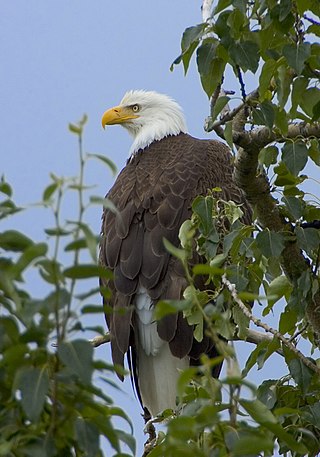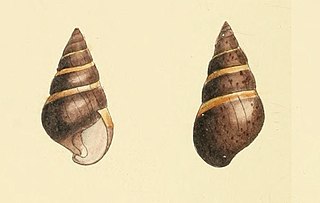
The Oceanian realm is one of the World Wildlife Fund (WWF) biogeographic realms, and is unique in not including any continental land mass. It has the smallest land area of any of the WWF realms.
Located about 2300 miles (3680 km) from the nearest continental shore, the Hawaiian Islands are the most isolated group of islands on the planet. The plant and animal life of the Hawaiian archipelago is the result of early, very infrequent colonizations of arriving species and the slow evolution of those species—in isolation from the rest of the world's flora and fauna—over a period of at least 5 million years. As a consequence, Hawai'i is home to a large number of endemic species. The radiation of species described by Charles Darwin in the Galapagos Islands which was critical to the formulation of his theory of evolution is far exceeded in the more isolated Hawaiian Islands.

Drepanis is a genus of Hawaiian honeycreeper in the subfamily Carduelinae of the family Fringillidae.

The Batrachedridae are a small family of tiny moths. These are small, slender moths which rest with their wings wrapped tightly around their bodies.

The fauna of the United States of America is all the animals living in the Continental United States and its surrounding seas and islands, the Hawaiian Archipelago, Alaska in the Arctic, and several island-territories in the Pacific and in the Caribbean. The U.S. has many endemic species found nowhere else on Earth. With most of the North American continent, the U.S. lies in the Nearctic, Neotropic, and Oceanic faunistic realms, and shares a great deal of its flora and fauna with the rest of the American supercontinent.

Avian malaria is a parasitic disease of birds, caused by parasite species belonging to the genera Plasmodium and Hemoproteus. The disease is transmitted by a dipteran vector including mosquitoes in the case of Plasmodium parasites and biting midges for Hemoproteus. The range of symptoms and effects of the parasite on its bird hosts is very wide, from asymptomatic cases to drastic population declines due to the disease, as is the case of the Hawaiian honeycreepers. The diversity of parasites is large, as it is estimated that there are approximately as many parasites as there are species of hosts. Co-speciation and host switching events have contributed to the broad range of hosts that these parasites can infect, causing avian malaria to be a widespread global disease, found everywhere except Antarctica.

Chloridops is an extinct genus of Hawaiian honeycreeper in the subfamily Carduelinae of the family Fringillidae.

Hemignathus is a Hawaiian honeycreeper genus in the subfamily Carduelinae of the finch family, Fringillidae.

Paroreomyza is a genus of Hawaiian honeycreeper in the subfamily Carduelinae of the family Fringillidae. These birds are endemic to Hawaii.

Hirasea is a genus of small, pulmonate land snails in the family Charopidae. This genus sees its highest diversity in the Hawaiian Islands, but species are distributed throughout Japan and Polynesia.

Amastra is a genus of small air-breathing land snails, terrestrial pulmonate gastropod mollusks in the family Amastridae.
Fauna Hawaiiensis or the Zoology of the Sandwich (Hawaiian) Isles is a three-volume work, published between 1899 and 1913, on the fauna of Hawaii. It was edited by David Sharp.
Robert Cyril Layton Perkins FRS was a distinguished British entomologist, ornithologist, and naturalist noted for his work on the fauna of the islands of Hawaii and on Hymenoptera. He is not to be confused with his son John Frederick Perkins, also a hymenopterist.
Praeacedes is a monotypic moth genus in the family Tineidae first described by Hans Georg Amsel in 1954. Its only species, Praeacedes atomosella, was first described by Francis Walker in 1863. It has a wide range and has been recorded from Europe, Australia, Hawaii, India, Malaysia, Solomon Islands, Easter Island, Mauritius, Madagascar, Réunion, South America and North America. The species has commonly been misidentified in various parts of the world.
Calliscelio is a parasitoid wasp monotypic genus which contains one species, C. elegans. It was first described as Caloteleia elegans on Oahu in the Hawaiian Islands in 1910 by British entomologist Robert Cyril Layton Perkins, who believed it not to be an indigenous species of Hawaii. Its pantropical species distribution is now well-established and it is still considered to be an adventive species in Hawaii. C. elegans was reassigned from its original genus to Caenoteleia in 1926 by French entomologist Jean-Jacques Kieffer and then to Calliscelio in 2009.

Satyu Yamaguti was a Japanese parasitologist, entomologist, and helminthologist. He was a specialist of mosquitoes and helminths such as digeneans, monogeneans, cestodes, acanthocephalans and nematodes. He also worked on the parasitic crustaceans Copepoda and Branchiura. Satyu Yamaguti wrote more than 60 scientific papers and, more importantly, several huge monographs which are still in use by scientists all over the world and were cited over 1,000 times each.

Chlorodrepanis is a genus of Hawaiian honeycreeper in the subfamily Carduelinae of the family Fringillidae.

Hydrophorinae is a subfamily of flies in the family Dolichopodidae. Several studies have found evidence that the subfamily in its current sense is polyphyletic.
Drosophila heteroneura is an endangered species of Hawaiian fly in the family Drosophilidae. This rare fly is part of the Hawaiian Drosophila lineage, and is only found in mesic and wet forests on the island of Hawaii.












